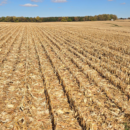FNC News
July 2023 Land Values Press Release
The agriculture real estate market entered a period of de-escalation beginning in the fourth quarter of 2022. The market experienced a reduction in both sales volume and value growth since that time, as interest rates increased, and inflation pressures became more apparent.
That trend has continued into the first half of 2023 with fewer properties being offered for sale and market values that, while still strong, are dramatically off the pace seen in the first half of 2022.
Results from the Federal Reserve District Surveys reflect this trend between the third and fourth quarter of 2022 and now continuing into the first half of 2023. Value growth is still positive across the Midwest, but increases are now in the single digits instead of the double digits seen in 2021 and 2022.
Farm operators remain the largest group of buyers through Farmers National Company, accounting for nearly 80 percent of all land sale transactions.
“These operators have enjoyed a period of high liquidity over the past five years but are now moving into a period of increasing debt service and borrowing. This will most likely result in less available cash reserve to deploy for capital expenditures and land purchases,” said Paul Schadegg, senior vice president of real estate operations for Farmers National Company. “While investors have not always been the successful buyer of properties offered for sale, they certainly are part of the equation, helping set a floor on land values and creating a competitive market. If farm operators step back from aggressive bidding for land, investors will most likely step in to take advantage of purchasing options.”
There continues to be a strong appetite for agriculture properties from individuals considering farm expansion and investment opportunities due to positive attributes of the ag economy. That overall bullish outlook for the ag economy will continue to drive the demand for high quality cropland, Schadegg noted.
Commodity markets will remain the primary driver in land sale activity and value moving forward.
“But with that being said, profitability is what will determine what the land market will bear. So, we must consider rising interest rates, inflation and supply chain into the overall picture,” Schadegg said. “Landowners continue to look for opportunity in the agriculture land market, deciding if this is the best time to sell at historic values or retain ownership of what continues to be a very valuable asset.”
The sales volume at Farmers National Company through the first half of 2023 continues to exceed the five-year average but is slightly off the “exceptional” pace set in 2021 and 2022. Motivated buyers continued to drive bidding at late spring sales, resulting in stable and strong values across all classes of land, Schadegg said.
“Looking ahead to the second half of 2023, we anticipate strong competition for high quality land offered for sale. The overall U.S. agriculture economy is healthy with Midwestern banks reporting increased operational lending but strong loan performance and projections for a profitable 2023 growing season. Our pipeline for scheduled fall sales is beginning to fill at a typical pace with buyers and sellers of farmland requesting information on upcoming sales,” Schadegg said.
“We remain confident that the strong demand for quality agriculture land will continue through the year. That opinion, coupled with the stable ag economy and a supply/demand scenario favoring the land owner, will maintain the current and long-term value of farmland across the U.S,” he added.
Regional Land Reports
East Region: Indiana, Ohio, Michigan, Kentucky, Illinois
Jay VanGordon, Area Sales Manager for Farmers National Company’s Eastern Region, shared that “farmland sale values remained strong for high quality land through the first half of 2023.”
“The volume of land for sale decreased year-over-year but activity for fall 2023 post-harvest sales is increasing,” VanGordon said.
Southern Region: Texas and Oklahoma
Market values remain strong in Texas and Oklahoma with strong demand for quality irrigated farms.
“Dry cropland and pasture values leveled in the recent months, but with recent rainfall the interest for these land types has increased,” said Tyler Ambrose, Farmers National Company Assistant Area Vice President for the Southern Region.
South Central Region: Kansas and Western Missouri
Buyer interest remains high, offering opportunities for landowners interested in marketing properties, noted Steve Morgan, Farmers National Company Area Sales Manager for the South-Central Region.
“Across Kansas and western Missouri, we are beginning to see values level off and a number of properties being offered to the market slowing,” Morgan said.
Western Region: Western Nebraska and Northeastern Colorado
High quality irrigated and dry land farms have leveled off at the market highs seen over the past two years, shared Farmers National Company Area Sales Manager Cole Nickerson.
“Lower quality land values have depressed slightly over the past six months,” Nickerson added.
West Central Region: Eastern Nebraska
Areas in eastern Nebraska have seen a slight softening of the market on lower or marginal quality ground in the past few months.
“Still, there appears to be good competition between buyers that have 1031 exchange money available for farmland purchases,” said Chanda Scheuring, Farmers National Company Area Sales Manager.
Central Region: Iowa
In Iowa, Farmers National Company continues to see very strong sale values for high quality Iowa cropland.
“However, we are not seeing the steady gains we experienced over the past two years. The one-year trend line for cropland value is certainly reflecting a plateau,” said Farmers National Company Area Sales Manager Tom Schutter.
Northern Regions: Dakotas and Western Minnesota
Drastic increases in farmland values have been in seen in the Dakotas and western Minnesota the past few years. But higher interest rates and the increased cost of crop inputs are putting pressure on land values in this area.
“Land values have leveled off and perhaps softened slightly from their highs in the fall of 2022. However, demand for farmland remains high with both farmers and investors with the lack of inventory on the market helping to offset the increase in interest rates and production costs,” said Troy Swee, Farmers National Company Area Sales Manager for the Dakotas.
More News




